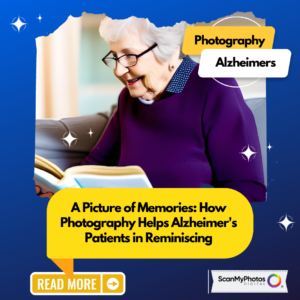We are reporting on how photography can help Alzheimer’s patients reminisce in today’s edition of PICTURE THIS!
 Alzheimer’s is a progressive neurological disorder affecting millions worldwide, causing memory loss, cognitive decline, and difficulty performing daily activities. As the disease advances, cherished memories of one’s past gradually slip away, leaving the individuals and their loved ones feeling helpless and heartbroken.
Alzheimer’s is a progressive neurological disorder affecting millions worldwide, causing memory loss, cognitive decline, and difficulty performing daily activities. As the disease advances, cherished memories of one’s past gradually slip away, leaving the individuals and their loved ones feeling helpless and heartbroken.
However, amid this challenging journey, photography emerges as a powerful tool that can rekindle long-forgotten memories and bring a ray of light to those living with Alzheimer’s. Sharing childhood pictures with Alzheimer’s patients can be a therapeutic way to help them reminisce, reconnect, and retain a sense of self amid the darkness of their condition.
The Power of Reminiscence
Reminiscence therapy has been widely recognized as an effective technique for individuals living with Alzheimer’s disease. By encouraging patients to recall past experiences, especially from childhood, caregivers and family members can forge emotional connections, trigger positive feelings, and promote a sense of identity. Reminiscing taps into preserved long-term memories, often more resilient than short-term memories that Alzheimer’s tends to impair. This project is ideal for digitizing those pictures at a trusted photo archival service like ScanMyPhotos.
The Role of Photography: Photography serves as an extraordinary aid in stimulating memories and emotions. Childhood pictures, in particular, have the potential to evoke robust responses from Alzheimer’s patients, as these early memories are usually the last to fade. Black and white photographs, sepia-toned images, or faded colors can transport individuals back to their formative years, creating a profound connection with their younger selves and, in turn, with the people and experiences of that time.
How Photography Can Help Alzheimer’s Patients
Emotional Stimulation: The act of looking at old photographs can trigger emotions that might have been buried deep within the recesses of an Alzheimer’s patient’s mind. Happy, nostalgic, and even sad feelings can resurface, allowing them to express themselves in ways that words might not enable.
Facilitating Communication: For Alzheimer’s patients who struggle with verbal communication, photographs become a universal language. As they view their childhood pictures, they can initiate conversations, share stories, and engage with their caregivers and loved ones more effectively.
Reducing Anxiety and Agitation: Alzheimer’s can cause restlessness and agitation due to the frustration of being unable to recall memories or recognize familiar faces. By sharing childhood pictures, caregivers can help ease this anxiety and create a calmer environment for the patient.
Reinforcing Identity: Alzheimer’s patients often experience a loss of self-identity, but photographs of their younger selves remind them of the person they once were, reinforcing their sense of identity and self-worth.
Fostering Connections: When family members and friends join in the reminiscing process, it strengthens the bond between them and the person with Alzheimer’s. These shared moments can create positive interactions and cherished memories for both parties.
How to Use Photography for Reminiscence
Gather and Organize Photographs: Collect a selection of childhood photographs of the individual and ensure they are organized in a chronological sequence. Physical photo albums or digital slideshows can be used for this purpose. Once located, get everything digitized to display on a TV screen.
<< How to get digital copies from photos, slides and reels of home movies >>
Choose Suitable Settings: Create a comfortable and quiet environment where patients can view the photographs without distractions. It’s essential to set a calm and positive atmosphere to encourage engagement.
Encourage Expression: As the person with Alzheimer’s looks at the photographs, encourage them to share any memories or feelings that come to mind. Be patient and listen attentively, allowing them to express themselves at their own pace.
Incorporate Music: Music can enhance the reminiscence process, as certain songs from their youth might trigger additional memories and emotions. Play some music from their era to complement the experience.
Involve Family and Friends: Sharing the reminiscence activity with loved ones can make it even more special. Encourage family members to share their own memories and stories related to the photographs, creating a collaborative and heartwarming atmosphere.
ScanMyPhotos acknowledges the potential of childhood photographs to foster emotional connections with Alzheimer’s patients. By facilitating reminiscence therapy in a peaceful and supportive environment with family members present, caregivers can capitalize on the soothing effects of looking at old photos to reduce anxiety and foster a sense of identity and self-worth for individuals with Alzheimer’s.




